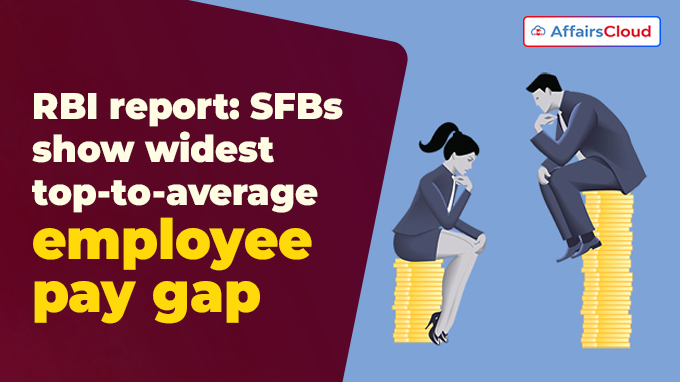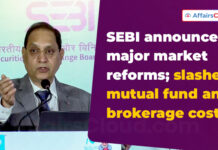 Recently, Reserve Bank of India (RBI) released the report titled “Report on Trend and Progress of Banking in India” (2022-2023).
Recently, Reserve Bank of India (RBI) released the report titled “Report on Trend and Progress of Banking in India” (2022-2023).
The report provides comprehensive data about the state of banking system in India.
Key Findings:
Small Finance Banks (SFBs) has the widest gap of remuneration between top executives and average employee
As per the RBI report, the gap in the remuneration between top executives and average employees is widest for Small Finance Banks (SFBs).
i.It mentioned that remuneration of Managing Director(MD) and Chief Executive Officer(CEO) of SFBs was 58.1 times the average employee pay in 2022.
- Compare to SFBs, remuneration of MD and CEO of Private Sector Banks(PVSBs), Public Sector Banks(PSBs) was 26.1 times and 2.4 times of average employee pay in 2022.
ii.The report cautioned that huge disparity of remuneration between top executives and average employees may prompt risk-taking behavior, which may further compromise the long-term objectives of bank.
iii.RBI has revised the guidelines that require minimum 50% of the total compensation should be variable.
- This would help to strike a balance between such disparity of remuneration and an incentive-based compensation structure.
RBI Data on Variable Pay(VP) for different banks in India:
- For Private Sector Banks (PVBs), share of variable pay in total remuneration increased from 31 %( at March-end 2021) to 39 %( at March-end 2022).
- For SFBs, it increased slightly from 25% to 26% during the same period.
- The share of non-cash components in the variable pay for PVBs decreased from 78 %( 2021) to 57 %( 2022).
- Similarly, for SFBs decreased from 41 %( 2021) to 34 %( 2022).
RBI flagged the interconnectedness of Small Finance Banks (SFBs) with Co-operative Banks
RBI in its report observed higher dependence of SFBs on deposits from the Co-operative banks at higher rate.
i.It showed the higher interconnectedness of SFBs with Co-operative Banks which means any shock to the Co-operative banks would directly impact the SFBs.
ii.One of the main reason for Small Finance Banks to borrow huge amount from cooperative bank is of low Current account and Savings Account(CASA) deposits.
- The Report highlighted by March-end2023, Total SFBs deposit is around 91 lakh crore and out of which 67.53% term deposits with balance being accounted for by CASA deposits.
- It also mentioned that SFBs credit-deposit ratio remained at around 92% which is higher than Scheduled Commercial Banks(SCBs).
iii.It cautioned entities like NBFCs(Non-Banking Financial Companies) and MFIs(Micro Finance Institutions) which were converted to Small Finance Banks posed a risk as they have higher share of unsecure microloans.
About Small Finance Banks(SFBs):
These banks are regulated and governed by RBI under Banking Regulation Act(1949) and RBI Act(1934).
- They are mainly responsible to provide banking services and credit under-served sections of population such as: micro and small industries, farmers and the unorganized sector units.
- Example of SFBs which are operational in India: Ujjivan Small Finance Bank, Equitas Small Finance Bank.
Urban Co-operative Banks need to avoid superannuation of directors: RBI
According to the report, RBI urged the Urban Co-operative Banks(UCBs) that they need to discourage very long and continuous tenures of their directors, in accordance with the provisions of the Banking Regulation Act(1949)
- It would help to reduce undue influence as well as bring transparency over the functioning of the board.
- It mentioned that induction of new directors will bring new ideas and perspectives in the Board.
i.It cautioned that in the absence of a comprehensive risk management policy, some UCBs are more prone to external and internal risks.
ii.As per the report, Till March-end 2023, There were total 1502 UCBs operating in India.
- But, it also underscored that nearly 33.33% (1/3rd) of newly licensed UCBs turned financially unviable.
- RBI started a process of mergers of unviable UCBs with viable entities in 2004-05.
- The UCB sector witnessed mergers of around 150 UCBs since 2004, including 3 (2022-23).
- Maharashtra and Gujarat, together contributed about 80% of total mergers.
- Total number of cancellations of UCBs since 2015-16 is 46.
RBI: Loans and Advances and Deposits related grievance surge in FY23
The RBI revealed that grievances related to loans and advances, deposits increased exponentially to 60%, 70% respectively at Reserve Bank of Ombudsman.
Key Points:
i.The data indicated that number of grievances related to loans and advances has increased from 30,734(FY22) to 59,762(FY23), which saw an increase of 94% year-on-year basis.
ii.Number of grievances related to deposit accounts has increased from 16,989(FY22) to 34,481(FY23).
iii.Grievances related to Public Sector Banks(PSBs) and Private Sector Banks(PVBs) accounted 43.5%, 31.4% of total complaints received respectively.
iv.Grievances for internet banking increased only by 2%(FY23), decreased by 3% compared to FY21.
v.Insurance, asset management related complaints increased to 73% in FY23.
vi.Report indicated slight growth for recently introduced RBI-Integrated Ombudsman Scheme(RBI-IOS):
- Total 4,68,854 cases were resolved by CRPC(Centralised Receipt and Processing Centre) in FY23. It helps to reduce burden of cases of RBI-IOS.
- List of Cases which comes under CRPC:
i.Non-Observance of Fair Practice Code
ii.Levy of charges without prior notice
iii.Direct selling and recovery agents
iv.Non-adherence to Banking Codes and Standards Board of India(BCSBI)
White –Label ATMS drives ATM growth in India
RBI report showed that total number of Automated Teller Machines(ATMs) in India increased by 3.5% in FY22. White-label ATM accounted maximum number of ATMs.
i.Among the ATM operated by Scheduled Commercial Banks(SCBs)(March-end2023):
- Public Sector Banks(PSBs) leads the ATM growth, accounted 63% of total ATMs in India.
ii.Private Sector Banks (PVBs) accounted 35% of total number of ATM in India. PVBs contributed total of 76,975 ATMs, out of which approx. 67.6% of PVB ATMs are in urban and semi-urban areas.
iii.Foreign Banks decreased from 1783 to 1231. They are more inclined towards urban areas for ATM than rural areas. They have bleak presence in rural areas with just 0.3% of their total ATMs.
iv.SFBs increased from 2207 to 2821(both on-site and off-site).
About White-Label ATMs:
- White-label ATMs(WLAs) are established, owned and operated by non-bank entities.
- They get authorization under the Payment & Settlement Systems Act,2007
- WLAs offers various banking services to customers such as: cash deposit, PIN change, account information and many more using either debit or credit cards issued by banks.
- There are different types of ATMs existed in banking system of India are:
National Financial Switch (NFS) manages all ATM network in India. It is administered by National Payments Corporation of India(NPCI).
i.Brown label ATM: these ATMs are given on lease to service providers but cash management and connectivity to banking networks is provided by sponsor bank.
ii.Orange-label ATM: is mainly used for share transactions.
iii.Yellow-label ATM: is mainly used for e-commerce purposes.
iv.Pink-label ATM: is accessed and used exclusively for women customers.
v.Green-label ATM: is used primarily for agricultural transactions.
Additional Information:
About Reserve Bank of India(RBI):
- Established: 1 April, 1935
- Headquarter: Mumbai, Maharashtra
- Governor: Shaktikanta Das(25th Governor of RBI)





